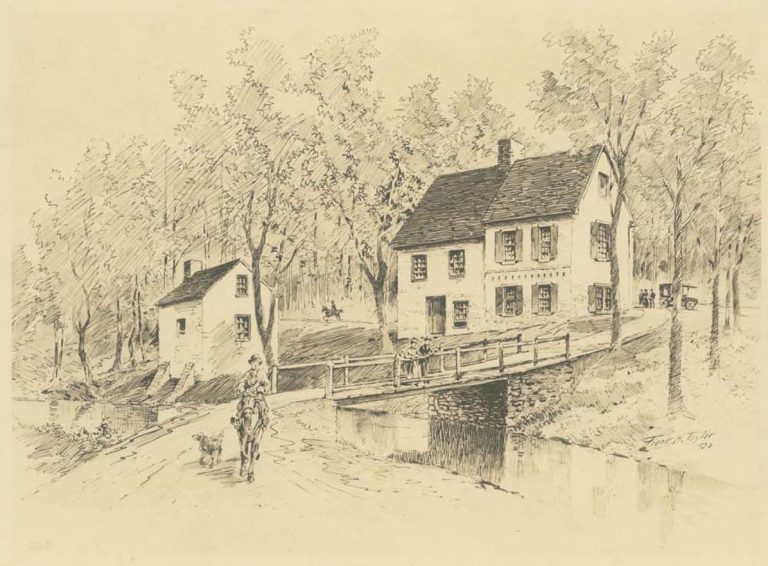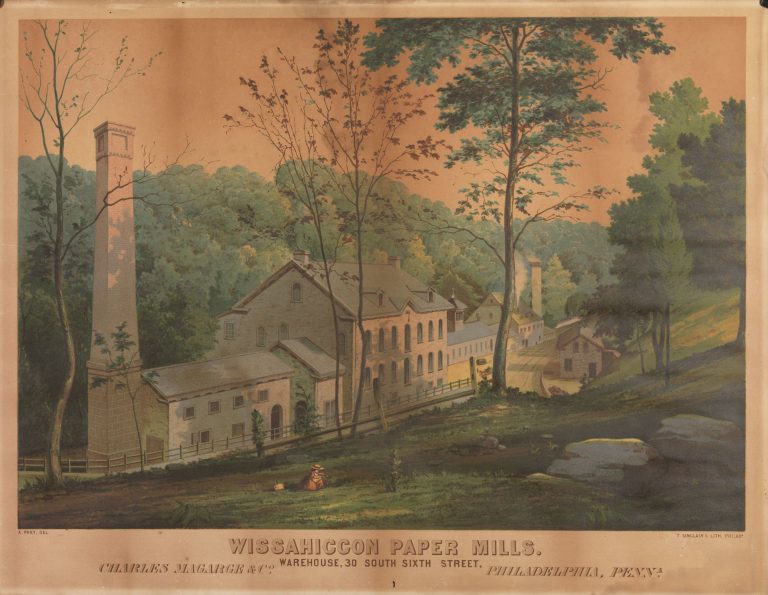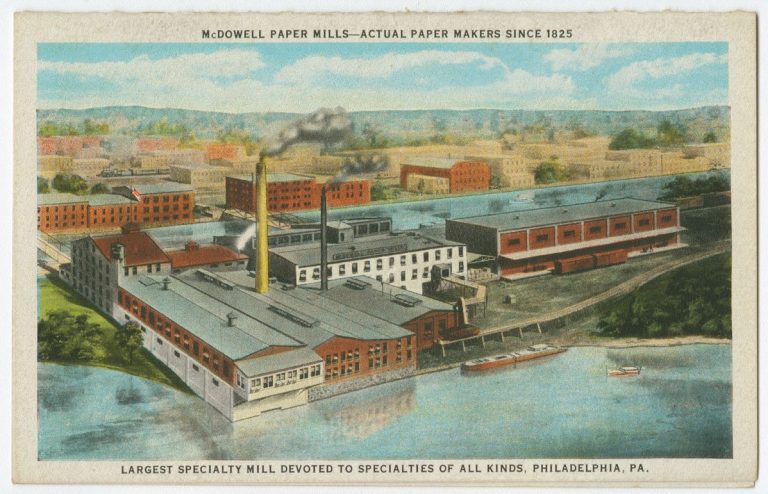Paper and Papermaking
By Jack McCarthy | Reader-Nominated Topic
Essay
Home to the first paper mill in the British American colonies, Philadelphia was the nation’s primary papermaking center through the early nineteenth century. The region lost its national preeminence in papermaking in the late nineteenth century, but it continued to host important makers of paper and paper products.
Skilled papermakers, including William Rittenhouse (1644–1708), a German-born Dutch Mennonite, and Thomas Willcox (c. 1689–1779), an English Catholic, were among the immigrants who came to southeastern Pennsylvania in the late seventeenth and early eighteenth centuries seeking religious freedom and economic opportunity. Rittenhouse settled near Germantown, where fellow Mennonites had founded a community and the Wissahickon Creek and its tributaries provided water power for papermaking. Willcox settled in Concord Township, Chester County (later part of Delaware County), where Chester Creek provided the same. In addition to their importance in early American papermaking, both men were religious leaders in their communities.
William Rittenhouse established British America’s first paper mill on the Monoshone Creek, a tributary to the Wissahickon, in 1690. It was the only paper mill in the colonies for twenty years. Claus Rittenhouse (1666–1734), William’s son, managed the mill with his father and became its proprietor following his father’s death. In 1710, Claus’s brother-in-law, William DeWeese (1677–1745), also a Dutch immigrant, built a second paper mill on the Wissahickon Creek nearby. Claus and several partners purchased the mill from DeWeese in 1713, while DeWeese and his son went on to build other paper mills in the Germantown area in the 1730s and 1740s. Several generations of the Rittenhouse family made paper at the original mill site through the mid-nineteenth century. Later renamed Historic Rittenhouse Town, the site was designated a National Historic Landmark in 1992.
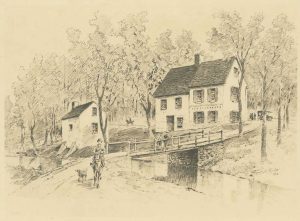
The colonies’ third paper mill was that of Thomas Willcox (c. 1689–1779), who in 1729 built what became known as Ivy Mills on Chester Creek in Concord Township, Chester County. Willcox was a key supplier of paper to Benjamin Franklin (1706–90) and other local printers. He and his descendants later specialized in making currency for colonial governments, the United States Treasury, and various South American and European countries. They also made checks for major banks. The Willcox family built another paper mill in nearby Glen Mills in 1836 and ran Ivy Mills until it closed in 1866. The Ivy Mills site, including the mill ruins and surviving nineteenth-century houses, was placed on the National Register of Historic Places in 1972.
Expanding Industry
Philadelphia’s rapidly growing population in the eighteenth century created a major demand for paper. By 1739 there were five paper mills in southeastern Pennsylvania; ten years later there were eleven. Powered by the region’s many waterways and the developing technical expertise of its mill operators, the Philadelphia area remained the center of America’s papermaking industry throughout the colonial period. Of the twenty-six paper mills operating in the thirteen colonies by 1769, twenty were in the Philadelphia area. Domestic production was not enough to meet local demand, however; most paper was imported in the eighteenth century.
Colonial Philadelphia was an important publishing center, and the city’s printers and publishers often had financial stakes in local paper mills to ensure a reliable source of paper for their businesses. Pennsylvania’s first printer, William Bradford (1663–1752), was a partner in the 1690 Rittenhouse mill, which was originally a partnership between Rittenhouse, Bradford, and two others before Rittenhouse bought out the other three. Germantown printer Christopher Sauer (1695–1758), the first German-language publisher in North America, and his son owned or had an interest in several mills in the Philadelphia area, while Benjamin Franklin was affiliated with at least four local paper mills by the late 1740s.
Another related industry was the manufacture of paper moulds, the screened frames used in early papermaking. Philadelphia engineer Nathan Sellers (1751–1830) began making paper moulds as early as 1776. The firm he established with his brother in 1779, N & D Sellers, was the nation’s primary manufacturer of paper moulds through the early nineteenth century. Sellers was a leading figure in a group of Philadelphia-area mechanical engineers and inventors that made the region a key center of technological innovation in the late eighteenth and early nineteenth centuries. Papermaking was one of many industries that saw major mechanical breakthroughs through the efforts of this group.
Innovation and Automation
Paper was generally made by hand in America until the introduction of mechanized production in the early nineteenth century. In 1816, Thomas Gilpin (1776–1853) patented the nation’s first papermaking machine and the following year put it into operation at his family’s Brandywine Paper Mill, which had been established in 1787 by Thomas’s brother Joshua Gilpin (1765–1841) on the Brandywine Creek, near Wilmington, Delaware. Thomas constructed the machine based on English models, using information provided by Joshua, who had toured Europe in the early nineteenth century and sent back materials on new papermaking technologies being developed in England. Early on, the Gilpins conferred with Benjamin Franklin on developments in the industry and later they supplied paper to another prominent Philadelphia publisher, Mathew Carey (1760–1839). The Sellers family also played a key role in the mechanization of papermaking. Coleman Sellers (1781–1834), Nathan’s son, took over the N & D Sellers firm in 1817 and invented various papermaking devices in the 1820s and a complete papermaking machine in 1832. By the 1830s, machine-based production had largely replaced traditional hand papermaking in America.
Although machines replaced water power in this period, paper makers continued to establish mills on waterways. A number of paper mills operated during the nineteenth century along the Brandywine Creek and its tributaries, running through central Chester County and northern Delaware. In 1833, James Guie (?-1893) opened the mill later known as Eagle Paper Mill on Beaver Creek, a tributary to the Brandywine Creek near Downingtown, Pennsylvania. Specializing in waterproof buckskin paper, the mill remained in operation for over 100 years. In 1843, Augustus Jessup (1797-1859) and his son-in-law Bloomfield Moore (1819-78) started the Jessup and Moore Paper Company on the lower Brandywine Creek in Kentmere, Delaware, not far from the Gilpin’s Brandywine Paper Mill. Jessup and Moore acquired other paper mills, both along the lower Brandywine and throughout the greater Philadelphia region, and the company eventually became one of the largest makers of book and magazine paper in the nation.
Demand for paper grew dramatically in the antebellum period, as America’s printing and publishing houses, many based in Philadelphia, produced an increasing number of newspapers, magazines, and books. Paper mills were established throughout the greater Delaware Valley to meet the demand. The Roxborough-Manayunk area became an especially important papermaking center in this period. This part of the city saw dramatic industrialization in the early nineteenth century, with the Schuylkill River and Manayunk Canal powering textile, paper, and other mills that were later converted to steam-production. Among the major paper producers in this area were the Flat Rock Paper Mill, owned by the Nixon family (descendants of William Rittenhouse); the Wissahickon Paper Mill, owned by the Megargee family; and the McDowell Paper Mills. All were family-run operations that were established in the 1820s through 1840s and continued in various capacities into the early twentieth century. Family members built new mills or established partnerships with other mills in the region over the years, resulting in a web of interrelated family-run paper businesses throughout the greater Philadelphia area.
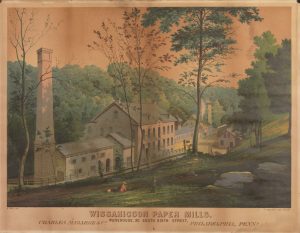
The introduction of paper made from wood pulp in the 1860s transformed the American paper industry. Paper had traditionally been made from cotton or linen rags, which were pulverized into fibers that were then formed into paper. Papermakers depended on rag collectors for their raw materials, and rags were often in short supply. In some cases, they were actually imported. Wood pulp proved a cheaper and more plentiful raw material and largely replaced rag-made paper over the course of the late nineteenth century, although straw was also used as a raw material. The American Wood Paper Company built the Manayunk Pulp Works adjacent to the Flat Rock Paper Mill in 1864. Martin Nixon (1818–88), part owner of the Flat Rock mill, managed the new pulp works.
Transition and Specialization
The industry’s transition from rag to wood pulp production coincided with Philadelphia’s decline as the nation’s preeminent papermaking center. Much of the paper industry’s growth in the late nineteenth century occurred in New York and New England, particularly Holyoke, Massachusetts, which became known as “The Paper City.” While no longer the national leader, the Philadelphia area continued to support a significant papermaking sector. In 1880 there were seven paper mills in Philadelphia, employing 452 workers; in 1912, there were eight, four in the Roxborough-Manayunk area. Among the largest were the McDowell and Dill & Collins mills. The latter firm had a mill in Port Richmond and also took over the Flat Rock mill. There were also dozens of paper mills operating in the surrounding counties in the nineteenth and early twentieth centuries.
Philadelphia was also an important center for specialty papermakers, including manufacturers of wallpaper and roofing paper in the nineteenth century, and later, in the twentieth century, cardboard, toilet tissue, and paper towels. Scott Paper, founded by brothers Edward Irvin (1846–1931) and Clarence (1848–1912) Scott in Philadelphia in 1879, was among the nation’s largest makers of toilet paper, paper towels, and tissues for much of the twentieth century. From 1971 to the mid-1990s the company headquarters was in Tinicum Township, Delaware County. John Connelly (1905–90) worked in the Philadelphia plant of Container Corporation of America in the 1940s before starting Connelly Container, a very successful cardboard box–making company, originally located on the site of the former McDowell Paper Mill in Manayunk. Both Scott Paper and Connelly Container eventually stopped local manufacturing operations and were acquired by other companies in the 1990s.
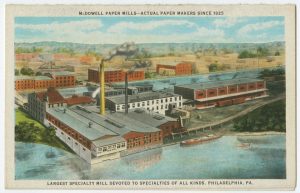
By the early twenty-first century, most of the Philadelphia-area paper mills had closed, leaving only a few major papermakers in the region. Newman Paper Board Company, established in 1919 and located on the Delaware River in lower Northeast Philadelphia, remained a family-run business into the early twenty-first century and was Pennsylvania’s leading recycler and supplier of rigid paperboard. Paperworks Industries, established in 2008 through the merger of several paper companies and headquartered in Bala Cynwyd, Montgomery County, operated a historic Manayunk paper mill for several years before closing it in 2017.
Although the industry declined in the twentieth century and operated at a fraction of its nineteenth-century heyday, Philadelphia played a key role as the birthplace and longtime center of early American papermaking.
Jack McCarthy is an archivist and historian who specializes in three areas of Philadelphia history: music, business and industry, and Northeast Philadelphia. He regularly writes, lectures, and gives tours on these subjects. His book In the Cradle of Industry and Liberty: A History of Manufacturing in Philadelphia was published in 2016 and he curated the 2017–18 exhibit Risk & Reward: Entrepreneurship and the Making of Philadelphia for the Abraham Lincoln Foundation of the Union League of Philadelphia. He serves as consulting archivist for the Philadelphia Orchestra and Mann Music Center and from 2011–16 directed a major archival project for the Historical Society of Pennsylvania focusing on the collections of the region’s many small historical repositories.
Copyright 2018, Rutgers University
Gallery
Backgrounders
Connecting Headlines with History
Links
- William Rittenhouse (Paper Discovery Center)
- Pennsylvania's Historical Industries: Papermaking (PennsylvaniaResearch.com)
- Manayunk (Workshop of the World)
- Exhibit Spotlights Printing and Papermaking at National Museum of Industrial History
- PhilaPlace: Historic Rittenhousetown (Historical Society of Pennsylvania)
